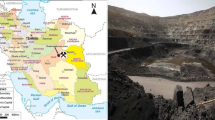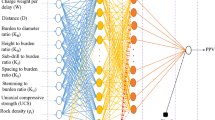Abstract
Blasting is a widely used technique for rock fragmentation in opencast mines and tunneling projects. Ground vibration is one of the most environmental effects produced by blasting operation. Therefore, the proper prediction of blast-induced ground vibrations is essential to identify safety area of blasting. This paper presents a predictive model based on gene expression programming (GEP) for estimating ground vibration produced by blasting operations conducted in a granite quarry, Malaysia. To achieve this aim, a total number of 102 blasting operations were investigated and relevant blasting parameters were measured. Furthermore, the most influential parameters on ground vibration, i.e., burden-to-spacing ratio, hole depth, stemming, powder factor, maximum charge per delay, and the distance from the blast face were considered and utilized to construct the GEP model. In order to show the capability of GEP model in estimating ground vibration, nonlinear multiple regression (NLMR) technique was also performed using the same datasets. The results demonstrated that the proposed model is able to predict blast-induced ground vibration more accurately than other developed technique. Coefficient of determination values of 0.914 and 0.874 for training and testing datasets of GEP model, respectively show superiority of this model in predicting ground vibration, while these values were obtained as 0.829 and 0.790 for NLMR model.






Similar content being viewed by others
References
Ahangari K, Moeinossadat SR, Behnia D (2015) Estimation of tunnelling-induced settlement by modern intelligent methods. Soils Found 55(4):737–748
Alavi AH, Gandomi AH (2011) A robust data mining approach for formulation of geotechnical engineering systems. Eng Comput (Swansea, Wales) 28(3):242–274
Alkroosh I, Nikraz H (2011) Correlation of pile axial capacity and CPT data using gene expression programming. Geotech Geol Eng 29(5):725–748
Ambraseys NR, Hendron AJ (1968) Dynamic behavior of rock masses: rock mechanics in engineering practices. Wiley, London
Baykasoglu A, Güllü H, Canakci H, Ozbakır L (2008) Prediction of compressive and tensile strength of limestone via genetic programming. Expert Syst Appl 35:111–123
Brownlee J (2011) Clever algorithms: nature-inspired programming recipes. Jason Brownlee, Melbourne
Bureau of Indian Standard (1973) Criteria for safety and design of structures subjected to underground blast. ISI Bull IS-6922
Çanakcı H, Baykasoğlu A, Güllü H (2009) Prediction of compressive and tensile strength of Gaziantep basalts via neural networks and gene expression programming. Neural Comput Appl 18(8):1031–1041
Davies B, Farmer IW, Attewell PB (1964) Ground vibrations from shallow sub-surface blasts. Engineer 217:553–559
Dindarloo SR (2015a) Prediction of blast-induced ground vibrations via genetic programming. Int J Min Sci Technol 25(6):1011–1015
Dindarloo SR (2015b) Peak particle velocity prediction using support vector machines: a surface blasting case study. J South Afr Inst Min Metall 115(7):637–643
Dindarloo SR, Siami-Irdemoosa E (2015) Estimating the unconfined compressive strength of carbonate rocks using gene expression programming. Eur J Sci Res 135(3):309–316
Dowding CH (1985) Blast vibration monitoring and control. Prentice- Hall, Englewoods Cliffs, pp 288–290
Duvall WI, Petkof B (1959) Spherical propagation of explosion of generated strain pulses in rocks. USBM, RI-5483
Ebrahimi E, Monjezi M, Khalesi MR, Jahed Armaghani D (2015) Prediction and optimization of back-break and rock fragmentation using an artificial neural network and a bee colony algorithm. Bull Eng Geol Environ. doi:10.1007/s10064-015-0720-2
Faramarzi F, Ebrahimi Farsangi MA, Mansouri H (2014) Simultaneous investigation of blast induced ground vibration and airblast effects on safety level of structures and human in surface blasting. Int J Min Sci Technol 24(5):663–669
Ferreira C (2001) Gene expression programming: a new adaptive algorithm for solving problems. Complex Syst 13(2):87–129
Ferreira C (2002) Gene expression programming in problem solving. In: Roy R et al (eds) Soft Computing and Industry, Springer, London, p 635–653
Ferreira C (2006) Gene expression programming: mathematical modeling by an artificial intelligence, 2nd edn. Springer, Germany
Fisne A, Kuzu C, Hüdaverdi T (2011) Prediction of environmental impacts of quarry blasting operation using fuzzy logic. Environ Monit Assess 174:461–470
Ghasemi E, Ataei M, Hashemolhosseini H (2013) Development of a fuzzy model for predicting ground vibration caused by rock blasting in surface mining. J Vib Control 19(5):755–770
Ghiasi M, Askarnejad N, Dindarloo SR, Shamsoddini H (2016) Prediction of blast boulders in open pit mines via multiple regression and artificial neural networks. Int J Min Sci Technol. doi:10.1016/j.ijmst.2015.12.001
Ghoraba S, Monjezi M, Talebi N, Moghadam MR, Jahed Armaghani D (2015) Prediction of ground vibration caused by blasting operations through a neural network approach: a case study of Gol-E-Gohar Iron Mine, Iran. J Zhejiang Univ Sci A. doi:10.1631/jzus.A1400252
Güllü H (2012) Prediction of peak ground acceleration by genetic expression programming and regression: a comparison using likelihood-based measure. Eng Geol 141:92–113
Hajihassani M, Jahed Armaghani D, Monjezi M, Mohamad ET, Marto A (2015a) Blast-induced air and ground vibration prediction: a particle swarm optimization-based artificial neural network approach. Environ Earth Sci 74:2799–2817
Hajihassani M, Jahed Armaghani D, Marto A, Tonnizam Mohamad E (2015b) Ground vibration prediction in quarry blasting through an artificial neural network optimized by imperialist competitive algorithm. Bull Eng Geol Environ 74:873–886
Hasanipanah M, Monjezi M, Shahnazar A, Jahed Armaghani D, Farazmand A (2015) Feasibility of indirect determination of blast induced ground vibration based on support vector machine. Measurement 75:289–297
Hudaverdi T (2012) Application of multivariate analysis for prediction of blast-induced ground vibrations. Soil Dyn Earthq Eng 43:300–308
Inc SPSS (2007) SPSS for windows (Version 160). SPSS Inc, Chicago
Iphar M, Yavuz M, Ak H (2008) Prediction of ground vibrations resulting from the blasting operations in an open-pit mine by adaptive neurofuzzy inference system. Environ Geol 56:97–107
Jahed Armaghani D, Hajihassani M, Mohamad ET, Marto A, Noorani SA (2014) Blasting-induced flyrock and ground vibration prediction through an expert artificial neural network based on particle swarm optimization. Arab J Geosci 7(12):5383–5396
Jahed Armaghani D, Momeni E, Abad SVANK, Khandelwal M (2015) Feasibility of ANFIS model for prediction of ground vibrations resulting from quarry blasting. Environ Earth Sci 74:2845–2860
Kahriman A (2002) Analysis of ground vibrations caused by bench blasting at can open-pit lignite mine in Turkey. Environ Earth Sci 41:653–661
Kayadelen C (2011) Soil liquefaction modeling by genetic expression programming and neuro-fuzzy. Expert Syst Appl 38:4080–4087
Khandelwal M, Kankar PK (2011) Prediction of blast-induced air overpressure using support vector machine. Arab J Geosci 4:427–433
Khandelwal M, Singh TN (2006) Prediction of blast induced ground vibrations and frequency in opencast mine: a neural network approach. J Sound Vib 289:711–725
Khandelwal M, Singh TN (2007) Evaluation of blasting induced ground vibration predictors. Soil Dyn Earthq Eng 27:116–125
Khandelwal M, Singh TN (2009) Prediction of blasting induced ground vibration using artificial neural network. Int J Rock Mech Min Sci 46:1214–1222
Khandelwal M, Kumar DL, Yellishetty M (2011) Application of soft computing to predict blast-induced ground vibration. Eng Comput 27(2):117–125
Langefors U, Kihlstrom B (1963) The modern technique of rock blasting. Wiley, New York
Li DT, Yan JL, Zhang L (2012) Prediction of blast-induced ground vibration using support vector machine by Tunnel excavation. Appl Mech Mater 170:1414–1418
Looney CG (1996) Advances in feed-forward neural networks: demystifying knowledge acquiring black boxes. IEEE Trans Knowl Data Eng 8(2):211–226
Mohamadnejad M, Gholami R, Ataei M (2012) Comparison of intelligence science techniques and empirical methods for prediction of blasting vibrations. Tunn Undergr Space Technol 28:238–244
Mohamed MT (2011) Performance of fuzzy logic and artificial neural network in prediction of ground and air vibrations. Int J Rock Mech Min Sci 48:845–851
Mollahasani A, Alavi AH, Gandomi AH (2011) Empirical modeling of plate load test moduli of soil via gene expression programming. Comput Geotech 38(2):281–286
Monjezi M, Ghafurikalajahi M, Bahrami A (2011) Prediction of blastinduced ground vibration using artificial neural networks. Tunn Undergr Space Technol 26:46–50
Monjezi M, Dehghani H, Singh TN, Sayadi AR, Gholinejad A (2012) Application of TOPSIS method for selecting the most appropriate blast design. Arab J Geosci 5(1):95–101
Monjezi M, Hasanipanah M, Khandelwal M (2013) Evaluation and prediction of blast-induced ground vibration at Shur River Dam, Iran, by artificial neural network. Neural Comput Appl 22:1637–1643
Nelson M, Illingworth WT (1990) A practical guide to neural nets. Addison-Wesley, Reading
Ozbek A, Unsal M, Dikec A (2013) Estimating uniaxial compressive strength of rocks using genetic expression programming. J Rock Mech Geotech Eng 5(4):325–329
Ozer U, Kahriman A, Aksoy M, Adiguzel D, Karadogan A (2008) The analysis of ground vibrations induced by bench blasting at Akyol quarry and practical blasting charts. Environ Geol 54:737–743
Roy PP (1993) Putting ground vibration predictors into practice. Colliery Guard 241:63–67
Sawmliana C, Roy PP, Singh RK, Singh TN (2007) Blast induced air overpressure and its prediction using artificial neural network. Min Technol 116(2):41–48
Shirani Faradonbeh R, Monjezi M, Jahed Armaghani D (2015) Genetic programing and non-linear multiple regression techniques to predict backbreak in blasting operation. Eng Comput. doi:10.1007/s00366-015-0404-3
Singh TN (2004) Artificial neural network approach for prediction and control of ground vibrations in mines. Min Technol 113(4):251–256
Singh TN, Singh V (2005) An intelligent approach to prediction and control ground vibration in mines. Geotech Geolog Eng 23:249–262
Singh TN, Dontha LK, Bhardwaj V (2008) Study into blast vibration and frequency using ANFIS and MVRA. Min Technol 117:116–121
Swingler K (1996) Applying neural networks: a practical guide. Academic Press, New York
Teodorescu L, Sherwood D (2008) High energy physics event selection with gene expression programming. Comput Phys Commun 178:409–419
Toraño J, Ramírez-Oyanguren P, Rodríguez R, Diego I (2006) Analysis of the environmental effects of ground vibrations produced by blasting in quarries. Int J Min Reclam Environ 20(4):249–266
Tripathy A, Singh TN, Kundu J (2015) Prediction of abrasiveness index of some Indian rocks using soft computing methods. Measurement 68:302–309
Verma AK, Maheshwar S (2014) Comparative study of intelligent prediction models for pressure wave velocity. J Geosci Geomatic 2(3):130–138
Verma AK, Singh TN (2011) Intelligent systems for ground vibration measurement: a comparative study. Eng Comput 27:225–233
Verma AK, Singh TN (2013a) A neuro-fuzzy approach for prediction of longitudinal wave velocity. Neural Comput Appl 22(7–8):1685–1693
Verma AK, Singh TN (2013b) Comparative study of cognitive systems for ground vibration measurements. Neural Comput Appl 22(1):341–350
Yagiz S, Gokceoglu C (2010) Application of fuzzy inference system and nonlinear regression models for predicting rock brittleness. Expert Sys Appl 37(3):2265–2272
Yagiz S, Gokceoglu C, Sezer E, Iplikci S (2009) Application of two non-linear prediction tools to the estimation of tunnel boring machine performance. Eng Appl Artif Intell 22(4):808–814
Yang Y, Zang O (1997) A hierarchical analysis for rock engineering using artificial neural networks. Rock Mech Rock Eng 30:207–222
Yang Y et al (2013) A new approach for predicting and collaborative evaluating the cutting force in face milling based on gene expression programming. J Netw Comput Appl 36(6):1540–1550
Zhou C, Xiao W, Tirpak TM, Nelson PC (2003) Evolving accurate and compact classification rules with gene expression programming. IEEE Trans Evol Comput 7(6):519–531
Acknowledgments
The authors would like to extend their appreciation to the Government of Malaysia and Universiti Teknologi Malaysia for the FRGS Grant No. 4F406 and for providing the required facilities that made this research possible.
Author information
Authors and Affiliations
Corresponding author
Rights and permissions
About this article
Cite this article
Shirani Faradonbeh, R., Jahed Armaghani, D., Abd Majid, M.Z. et al. Prediction of ground vibration due to quarry blasting based on gene expression programming: a new model for peak particle velocity prediction. Int. J. Environ. Sci. Technol. 13, 1453–1464 (2016). https://doi.org/10.1007/s13762-016-0979-2
Received:
Revised:
Accepted:
Published:
Issue Date:
DOI: https://doi.org/10.1007/s13762-016-0979-2




